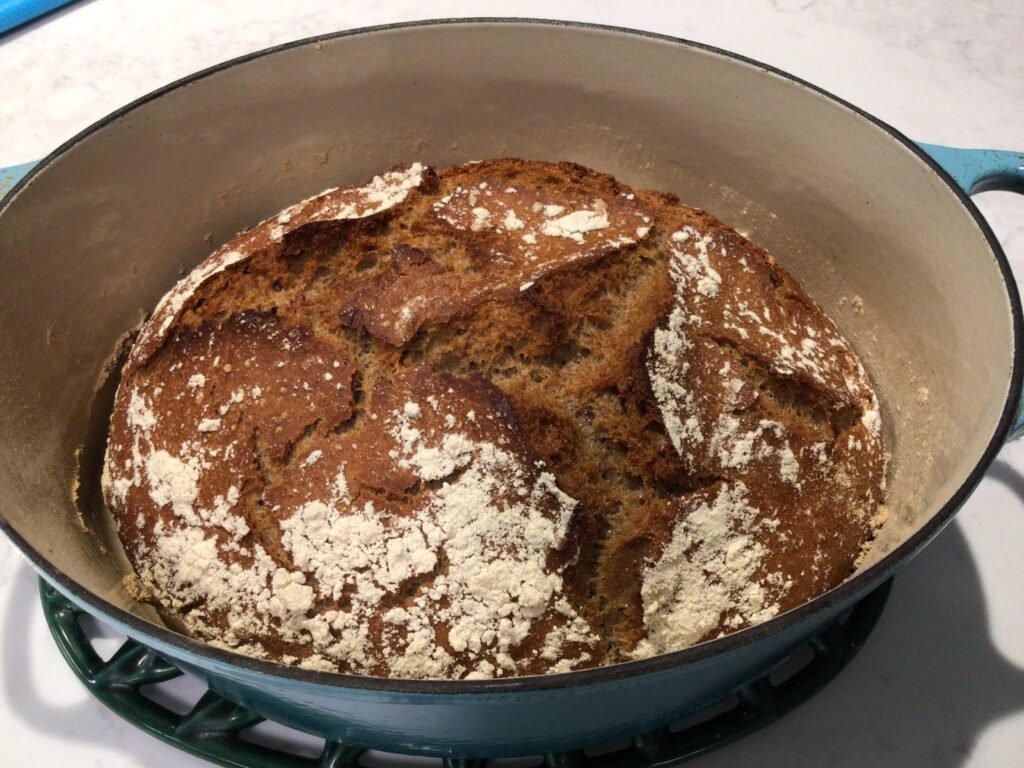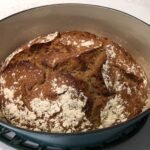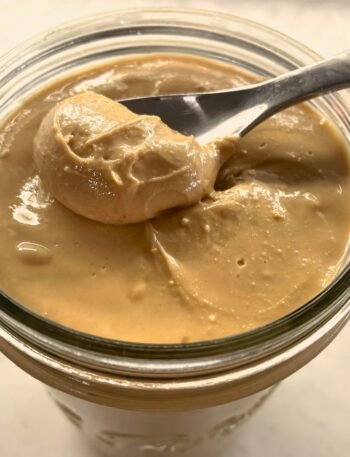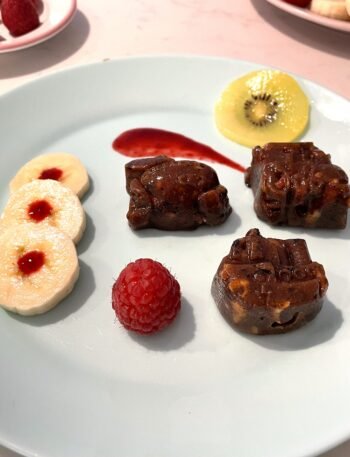
This is a special post for my friends Wilma & Joshua, who are interested in making their own bread. Hi friends ! 🙂
It will also be of some interest for people like us, who are now healthy, still following the SCD diet most of the time, but able to tolerate a few exceptions.
I still consider gluten as not being a healthy food. BUT if I am to eat gluten, there is gluten…. and gluten :-).
Let me explain : if you eat a quickly-raised white bread, made with low-cost all purpose wheat flour, yeast, and a ton of salt (necessary for flavor and rise), IMO, it’s definitely not healthy : glycemic index is very high, salt content is too high, and it will contain a lot of phytic acid, which will prevent you from absorbing the few vitamins and minerals it might contain, or your meal contains. You will also feed a lot of bad bacteria in your gut, due to all the bad sugars contained in the bread.
If you’ve been cleaning up your body with a strict diet like the SCD, you will have side effects with this bread. (We are definitely prone to overreacting to bad foods, after the SCD diet. Which is a pretty good thing IMO ! Now we know what our body likes, or not.)
But if you’re eating a bread made with organic all-purpose spelt flour, rye flour, whole grain spelt flour, or, even better, einkorn flour (lowest gluten content with rye)…. If, instead of yeast, you use sourdough (best scenario), or a fermented dough made with a tiny quantity of yeast…. Then the result on your body is completely different – assuming you’re healthy when you eat it. No tiredness after eating, no brain fog, no heartburn……Just try 🙂
This year, for Christmas, as every year, we made and enjoyed homemade bread. We don’t do gluten anymore – maybe 3-4 times a year for celebrations. Therefore, it doesn’t make sense to raise/feed a sourdough (I’d have to throw away tons of sourdough every 2-3 days).
If you do eat bread on a regular basis, and want to raise a sourdough, feel free to reach me out, I’ll be happy to help out on that !
So what’s the solution to enjoy bread exceptionnally, without sourdough ? No-knead bread.
Basically, you’ll need a digital scale (yes, I’m repeating myself :-). Unless you’re very experimented with any kind of recipe, you need a scale – how would you weight 8g of salt otherwise?
And you’re going to make a very hydrated dough (nothing to do with regular dough, if you’re interested in regular kneaded dough, let me know).
To get it, you’re going to add, in a very large bowl, your flour(s) & salt, a lot of water, a pinch of yeast, mix with a large spoon until everything is well combined, but not overmix – contrary to a regular bread, you do NOT want gluten to develop its elasticity.
Then cover with a lid, and leave it on the kitchen counter for 12 to 18h. No mixing, no touching, no action at all – let the magic happen effortless 😉
The dough will triple in volume over the 12 to 18h.
18h gives a more “sourdough-y” flavor, but if you’re in a hurry, 12h is an acceptable result. I do not recommend less than 12h though, and I encourage you to organize and leave it for 18h.
Once the resting time is over, heat your oven at 500F with an open cast-iron pot inside, putting its lid in the oven on the side. You want both pieces to be burning hot.
You’re going to “pull back” the dough a few times (video to be posted). Basically, you’ll take the outside of the dough all around the bowl, and bring it back to the middle.
Once the oven and the pot are hot, take the pot out of the oven, and leave the oven closed and running. Quickly dust a large amount of flour at the bottom of the pot (enough to cover the bottom entirely), and immediately pour the dough in the pot, before the flour burns. Don’t try to make the dough even, it will take its place naturally while cooking. Just drop it as quickly as possible in the cast-iron pot – you want to keep as much heat as possible.
Dust some flour on top of the dough if you like – optional, but it gives a more authentic look 🙂
Close the pot with its lid, put the pot back in the oven. After 5′, lower the temperature to 450°F. Cook for 40′.
Turn off the heat, let the bread sit 10 to 15′ more in the oven (don’t open the oven & don’t touch the lid).
Remove the cast-iron pot from the oven, open it, remove the bread (it should come out easily if it’s perfectly cooked) and let it cool on a rack.
If you’re able to resist the smell of freshly baked bread….. Please note that it’s even better on the next day 🙂
No-Knead bread – the healthiest real bread you’ll ever be able to make (non SCD)
Ingredients
- 500 g whole grain spelt flour, or einkorn flour, and rye (optional) (or a mix ; I like to do 75g of rye + 425g einkorn or sprouted spelt)
- 500 g water
- 8 g salt (up to 9g depending on taste and flour, see notes)
- ¼ tsp yeast
Instructions
- Mix, in a very large bowl, your flour(s) & salt. Add water + yeast, and mix with a large spoon until everything is well combined (but do not overmix – contrary to a regular bread, you do NOT want gluten to develop its elasticity).
- Cover with a lid, and leave the bowl on the kitchen counter for 12 to 18h. No mixing, no touching, no action at all – let the nature do its job 😉
- The dough will triple in volume over the 12 to 18h.18h gives a more "sourdough-y" flavor, and a slightly more "airy" dough. But if you're really in a hurry, 12h is an acceptable result.
- Once the resting time is over, heat your oven at 500F with an open cast-iron pot inside, putting its lid in the oven as well, on the side. You want both pieces to be burning hot. "Pull back" the dough a few times (video to be posted). Basically, you'll take the outside of the dough all around the bowl, and bring it back to the middle.
- Once the oven and the pot are hot, take the pot out of the oven (and keep the the oven closed and running). Quickly dust a large amount of flour at the bottom (enough to cover the bottom entirely), and immediately pour the dough in the pot, before the flour burns. Don't try to make the dough even, it will take its place naturally while cooking. Just drop it as quickly as possible in the cast-iron pot – you want to keep the heat.
- Dust some flour on top of the dough if you like – it's optional, but it gives a more authentic look 🙂
- Close the pot with its lid, and put it immediately back in the hot oven. After 5', lower the temperature to 450°F. Cook for 40'. Do NOT open the pot while it's cooking. Turn off the heat, let the bread sit 10 to 15' more in the oven (do not open the oven & do not open the lid).
- Remove the cast-iron pot from the oven, open it, remove the bread (it should come out easily if it's perfectly cooked) and let it cool on a rack before slicing.
- If you’re able to resist the smell of freshly baked bread….. Please note that it’s even better on the next day 🙂
Notes
Set it to 500°F and leave it to cook for 1h before turning off the oven (do not open the lid at any time). Let it sit 15′ (still leaving the lid closed), before removing it from the oven, then from the pot, and let it cool on a rack. If you don’t own a cast-iron pot, and have a glass pot with a lid, it will also work. Add a parchment paper in the pot, and dust it with flour. Do start in cold oven. As a general rule, you’ll need an average of 100% hydratation with whole grains flours, for a no-knead bread (= same weight of flour and water). If you’re using all purpose flour, 70% to 80 % should be enough (= for 1 kg of flour, 700 to 800g of water).
It’s a fool proof recipe…. as long as your dough is slighly liquid (thicker than a pancake dough, but not dry and thick like a cookie dough), your bread will come out good.
If your dough is too liquid, the bread will take a little longer to cook. That’s it. And this should be covered by the 10-15′ resting time at the end. Rye and barley are dense flours, with very low gluten content. To get the best result, replace 10 to 20% of your total amount of flour with rye or barley ( = 50 to 100g for a total of 500g of flour). Don’t go above 20% or you’ll have a dense bread. If you like your bread on the salty side, you can increase the salt up to 18g / kg of flour. I find that rye adds so much favor, that you need less salt. It’s really up to you.
Join Cooking Evolution community and get ready to immerse yourself in a culinary adventure like never before!





